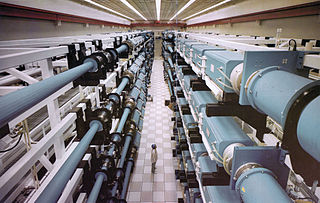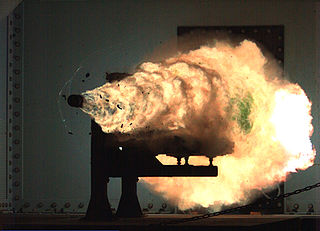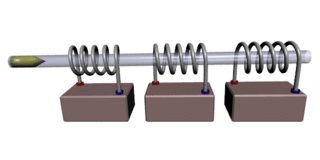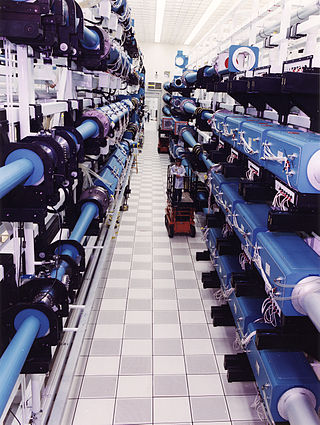
Inertial confinement fusion (ICF) is a fusion energy process that initiates nuclear fusion reactions by compressing and heating targets filled with fuel. The targets are small pellets, typically containing deuterium (2H) and tritium (3H).

A railgun or rail gun, sometimes referred to as a rail cannon, is a linear motor device, typically designed as a weapon, that uses electromagnetic force to launch high-velocity projectiles. The projectile normally does not contain explosives, instead relying on the projectile's high kinetic energy to inflict damage. The railgun uses a pair of parallel conductors (rails), along which a sliding armature is accelerated by the electromagnetic effects of a current that flows down one rail, into the armature and then back along the other rail. It is based on principles similar to those of the homopolar motor.
An explosively pumped flux compression generator (EPFCG) is a device used to generate a high-power electromagnetic pulse by compressing magnetic flux using high explosive.

A coilgun is a type of mass driver consisting of one or more coils used as electromagnets in the configuration of a linear motor that accelerate a ferromagnetic or conducting projectile to high velocity. In almost all coilgun configurations, the coils and the gun barrel are arranged on a common axis. A coilgun is not a rifle as the barrel is smoothbore.

The National Ignition Facility (NIF) is a laser-based inertial confinement fusion (ICF) research device, located at Lawrence Livermore National Laboratory in Livermore, California, United States. NIF's mission is to achieve fusion ignition with high energy gain. It achieved the first instance of scientific breakeven controlled fusion in an experiment on December 5, 2022, with an energy gain factor of 1.5. It supports nuclear weapon maintenance and design by studying the behavior of matter under the conditions found within nuclear explosions.

In fusion power research, the Z-pinch is a type of plasma confinement system that uses an electric current in the plasma to generate a magnetic field that compresses it. These systems were originally referred to simply as pinch or Bennett pinch, but the introduction of the θ-pinch concept led to the need for clearer, more precise terminology.

A spheromak is an arrangement of plasma formed into a toroidal shape similar to a smoke ring. The spheromak contains large internal electric currents and their associated magnetic fields arranged so the magnetohydrodynamic forces within the spheromak are nearly balanced, resulting in long-lived (microsecond) confinement times without external fields. Spheromaks belong to a type of plasma configuration referred to as the compact toroids. A spheromak can be made and sustained using magnetic flux injection, leading to a dynomak.
MARAUDER was a United States Air Force Research Laboratory project concerning the development of a coaxial plasma railgun. The first computer simulations occurred in 1990, and its first published experiment appeared on August 1, 1993.

The Shiva laser was a powerful 20-beam infrared neodymium glass laser built at Lawrence Livermore National Laboratory in 1977 for the study of inertial confinement fusion (ICF) and long-scale-length laser-plasma interactions. Presumably, the device was named after the multi-armed form of the Hindu god Shiva, due to the laser's multi-beamed structure. Shiva was instrumental in demonstrating a particular problem in compressing targets with lasers, leading to a major new device being constructed to address these problems, the Nova laser.

Nova was a high-power laser built at the Lawrence Livermore National Laboratory (LLNL) in California, United States, in 1984 which conducted advanced inertial confinement fusion (ICF) experiments until its dismantling in 1999. Nova was the first ICF experiment built with the intention of reaching "ignition", a chain reaction of nuclear fusion that releases a large amount of energy. Although Nova failed in this goal, the data it generated clearly defined the problem as being mostly a result of Rayleigh–Taylor instability, leading to the design of the National Ignition Facility, Nova's successor. Nova also generated considerable amounts of data on high-density matter physics, regardless of the lack of ignition, which is useful both in fusion power and nuclear weapons research.
A dense plasma focus (DPF) is a type of plasma generating system originally developed as a fusion power device starting in the early 1960s. The system demonstrated scaling laws that suggested it would not be useful in the commercial power role, and since the 1980s it has been used primarily as a fusion teaching system, and as a source of neutrons and X-rays.

Inertial Fusion Energy is a proposed approach to building a nuclear fusion power plant based on performing inertial confinement fusion at industrial scale. This approach to fusion power is still in a research phase. ICF first developed shortly after the development of the laser in 1960, but was a classified US research program during its earliest years. In 1972, John Nuckolls wrote a paper predicting that compressing a target could create conditions where fusion reactions are chained together, a process known as fusion ignition or a burning plasma. On August 8, 2021, the NIF at Livermore National Laboratory became the first ICF facility in the world to demonstrate this. This breakthrough drove the US Department of Energy to create an Inertial Fusion Energy program in 2022 with a budget of 3 million dollars in its first year.

The High Power laser Energy Research facility (HiPER), is a proposed experimental laser-driven inertial confinement fusion (ICF) device undergoing preliminary design for possible construction in the European Union. As of 2019, the effort appears to be inactive.
Magnetized target fusion (MTF) is a fusion power concept that combines features of magnetic confinement fusion (MCF) and inertial confinement fusion (ICF). Like the magnetic approach, the fusion fuel is confined at lower density by magnetic fields while it is heated into a plasma. As with the inertial approach, fusion is initiated by rapidly squeezing the target to greatly increase fuel density and temperature. Although the resulting density is far lower than in ICF, it is thought that the combination of longer confinement times and better heat retention will let MTF operate, yet be easier to build. The term magneto-inertial fusion (MIF) is similar, but encompasses a wider variety of arrangements. The two terms are often applied interchangeably to experiments.
General Fusion is a Canadian company based in Richmond, British Columbia, which is developing a fusion power technology based on magnetized target fusion (MTF). The company was founded in 2002 by Dr. Michel Laberge. The company has more than 150 employees.

Magnetized liner inertial fusion (MagLIF) is an ongoing fusion power experiment being carried out on the Z Pulsed Power Facility at Sandia National Laboratories in the US. Is it one example of the broader magneto-inertial fusion approach, which attempts to compress a pre-heated plasma. The goal is to produce fusion conditions without the level of compression needed in the inertial confinement fusion (ICF) approach, where the required densities reach about 100 times that of lead.
Magneto-inertial fusion (MIF) describes a class of fusion power devices that combine aspects of magnetic confinement fusion and inertial confinement fusion in an attempt to lower the cost of fusion devices. MIF uses magnetic fields to confine an initial warm, low-density plasma, then compresses that plasma to fusion conditions using an impulsive driver or "liner." The concept is also known as magnetized target fusion (MTF) and magnitnoye obzhariye (MAGO) in Russia.
A plasma railgun is a linear accelerator which, like a projectile railgun, uses two long parallel electrodes to accelerate a "sliding short" armature. However, in a plasma railgun, the armature and ejected projectile consists of plasma, or hot, ionized, gas-like particles, instead of a solid slug of material. Scientific plasma railguns are typically operated in vacuum and not at air pressure. They are of value because they produce muzzle velocities of up to several hundreds of kilometers per second. Because of this, these devices have applications in magnetic confinement fusion (MCF), magneto-inertial fusion (MIF), high energy density physics research (HEDP), laboratory astrophysics, and as a plasma propulsion engine for spacecraft.

The Linus program was an experimental fusion power project developed by the United States Naval Research Laboratory (NRL) starting in 1971. The goal of the project was to produce a controlled fusion reaction by compressing plasma inside a metal liner. The basic concept is today known as magnetized target fusion.
Heavy ion fusion is a fusion energy concept that uses a stream of high-energy ions from a particle accelerator to rapidly heat and compress a small pellet of fusion fuel. It is a subclass of the larger inertial confinement fusion (ICF) approach, replacing the more typical laser systems with an accelerator.












